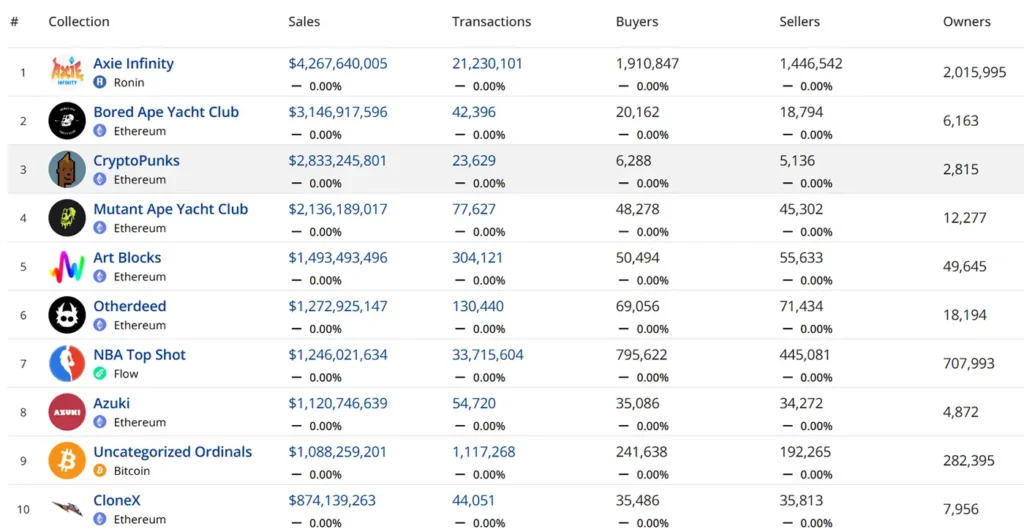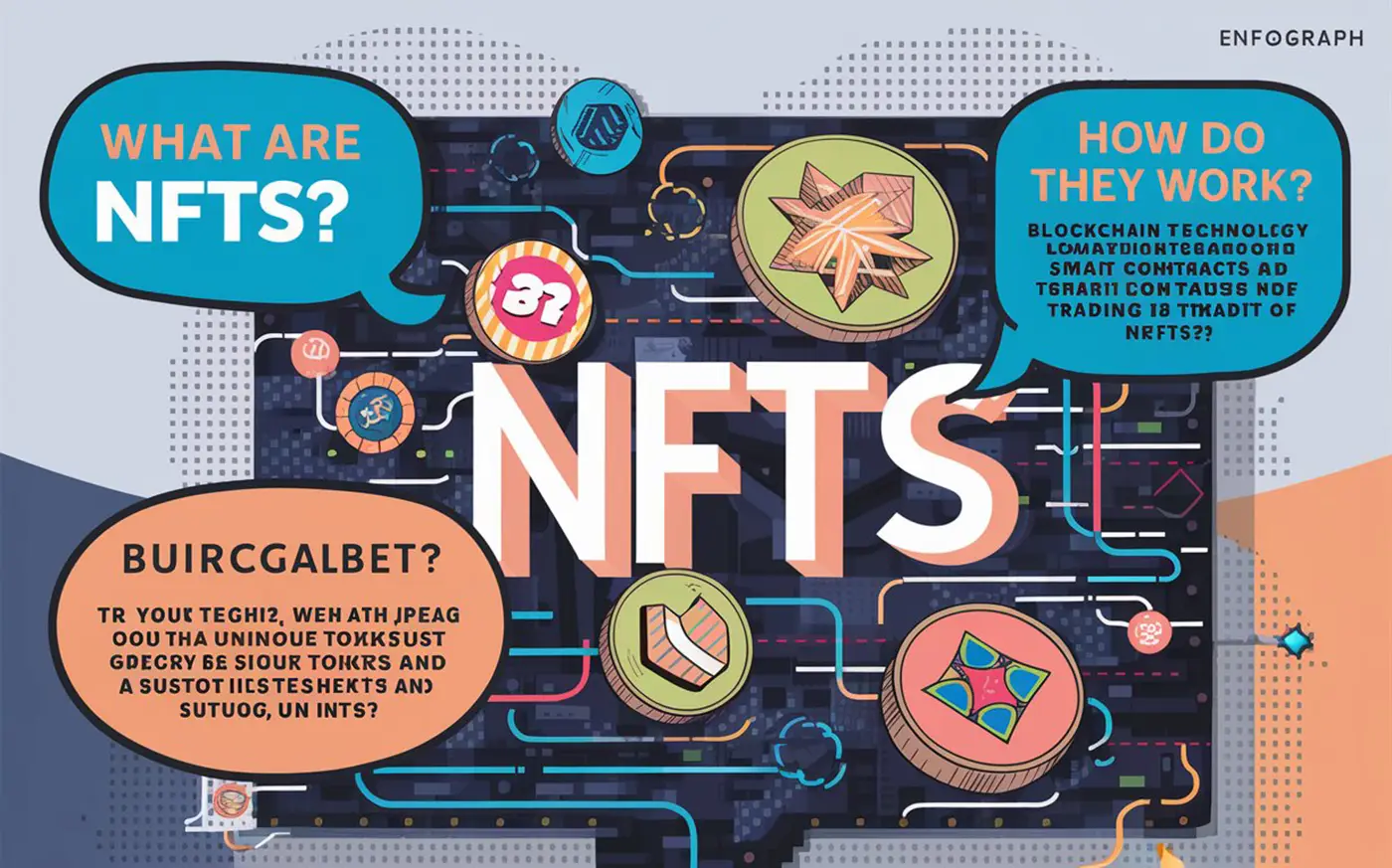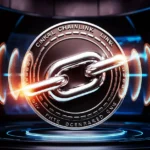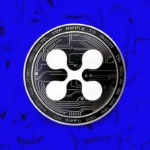Non-fungible tokens (NFTs) have amassed much popularity in the recent days. Celebrities, gaming companies, etc., are all venturing into this fast-growing space that leverages the potential of blockchain technology.
NFT assets have not only exploded in popularity but also in value. Images of Apes have been sold on trading platforms for tens of millions of dollars. Such sales have attracted attention, with non-native crypto traders wondering what the buzz around these digital asses is all about.
This article will answer the critical question that many people have, “what are NFTs, and how do they work?” We will also dive into how these digital assets work and how they are used.
What are NFTs
To best answer the question “what are NFTs and how do they work?” we first need to understand the basics of these digital assets.
NFTs are digital assets that harbor identifying information embedded in smart contracts. The embedded information makes every NFT unique. These tokens guarantee authenticity as another token cannot replace them.
NFTs cannot be swapped as no one NFT is the same as another. For instance, while swapping banknotes of the same value, you cannot swap two NFTs and still have the original value. As such, no one NFT is the same as another.
Bitcoin and other cryptocurrencies are fungible. You can exchange one Bitcoin for another, and while the value of fiat might change, you will still own one Bitcoin. You can also divide Bitcoin to own a fraction of a Bitcoin.
The same thing cannot be said for NFTs. You cannot trade a fraction of an NFT because its value is in being whole. Just like you cannot get half a concert ticket, you cannot get half an NFT, making them non-fungible.
How Do NFTs Work?

Most NFTs are created on the Ethereum blockchain, also popularly known as the “king of smart contracts.” However, other blockchain networks, including Solana, Tezos, and TRON, have sprouted over the years to support these digital assets.
In NFTs, you can add detailed features such as metadata, file links, and the owner’s identity. These features set each NFT apart from the other to promote uniqueness and authenticity.
NFTs have the potential to prove digital ownership, a vital feature in the fast-growing digital space. By leveraging blockchain technology, NFTs promise trustless security on the ownership and exchange of digital assets.
NFTs leverage the immutable and transparent nature of blockchains. These digital assets are stored transparently, enabling people to verify the authenticity of every NFT.
NFT transactions are recorded permanently on the blockchain and contain a timestamp, making it possible to trace the NFT from when it was first created.
Uses and Applications of NFTs
Now that we have a basic understanding of “what are NFTs and how do they work?” the next step is to evaluate the uses and applications of these digital assets.
Below are some of the critical uses and applications of NFTs that best answer the question, “Are NFTs dead?”
Gaming
The first significant use case of NFTs is in the gaming industry. In gaming, NFTs allow in-game elements to be tokenized and exchanged with peers.
The adoption of NFTs in gaming started with CryptoKitties. In 2017, CryptoKitties launched the first NFTs, depicting a digital kitten. Since then, NFTs have become a significant concept in gaming, with blockchain-native games such as Axie Infinity sprouting up.
Traditional gaming companies are also venturing into the space. Square Enix, the creator of the popular gaming title Final Fantasy, also released an NFT game, Symbiogenesis.
Sports
The sports industry is also recording a significant uptick in NFT usage. The most popular use case is the NBA Top Shot. This project allows basketball fans to collect memorable moments captured during games and trade them on NFT marketplaces.
NFTs are also behind the revolution of fan tokens through social platforms such as Sorare. Sorare has partnered with some of the largest sports leagues to boost fan engagement through digital cards.
Art
The most commendable use case of NFTs in the art industry happened with Beeple. In 2021, artwork by an artist known as Beeple sold as an NFT for a whopping $69.3 million in an online auction.
Since then, NFTs have become widely adopted in the digital space. In 2022, Pace Galleries announced the winter 2022 NFT releases featuring NFT projects.
The growing use case of NFTs in the art industry follows these digital assets’ transparent and immutable nature. NFTs solve the problem of counterfeits in the art industry, which has helped drive value.
Virtual Worlds
NFTs have also become increasingly popular in the virtual worlds, commonly known as the metaverse. The metaverse is a blockchain-powered world where NFTs are used as a representation of people or assets.
Getting Started With NFTs

NFTs are becoming increasingly popular, and crypto investors looking to diversify their portfolios are exploring this space, which has a notably high growth potential. However, understanding the basics is paramount before getting started with these digital assets.
Some NFTs are pricey, while others are low-cost. If you are just getting started with NFTs, it is recommended that you begin by exploring low-cost assets. Popular collections such as the Bored Ape Yacht Club (BAYC) and CryptoPunks are highly priced.
You should also be aware of NFT traders’ tools to get data such as the price, sales, trading volumes, etc. The most popular tool used by NFT traders is CryptoSlam.

The data above shows the ranking of top NFT collections in terms of sales. If you are wondering, “Are NFTs still a thing?”, such data will help you know the most popular collections in the market.
How To Buy And Sell NFTs
The process of buying and selling NFTs is similar to buying cryptocurrencies. Below are the steps to follow:
- Step 1: Open an account on an NFT marketplace
The first step is to create an account on a marketplace supporting the buying and selling of NFTs. The most popular NFT marketplaces are Rarible, OpenSea, Blur, and SuperRare.
- Step 2: Connect your digital wallet
After opening your account, go ahead and connect your digital wallet. If you want to buy an NFT created on Ethereum, you should ensure the wallet contains ETH. The NFTs are priced in the value of the native token of the blockchain they were made.
- Step 3: Buy the NFT
After connecting the wallet, place an order to buy the NFT. To do so, search for the NFT you want on the marketplace and purchase it. Once your order is confirmed, the NFT will be transferred to your wallet address.
The process is nearly the same if you intend to sell the NFT. Go to the NFT marketplace and click sell to the NFT you want to select. Select whether you want a fixed-price listing or an auction, and set the price at which you want to sell the NFT.
You will have to pay gas fees to buy and sell NFTs. Gas fees are like transaction fees for using a blockchain.
The Bottom Line
NFTs have become increasingly popular in the digital asset industry. These digital assets represent real-life assets. They leverage blockchain technology and smart contracts for transparency, security, and immutability.
If you are wondering, “what are NFTs and how do they work?” you should explore the use cases of these digital assets. These assets are used in many areas, including gaming, sports, real estate, art, etc.
FAQs
-
What are NFTs?
NFTs are tradable digital assets with information verifying the identity of the person behind the wallet. They are unique assets created on the blockchain that cannot be replicated.
-
How are NFTs different from cryptocurrencies like Bitcoin or Ethereum?
NFTs are different from Bitcoin or Ethereum. Bitcoin and Ethereum are fungible and divisible. However, NFTs are non-fungible as they cannot be freely traded or replaced for another asset of the same value. Unlike cryptocurrencies, NFTs cannot be divided.
-
How are NFTs created and stored?
NFTs are created using smart contracts. They run on blockchain technology to promote transparency and immutability. These digital assets are stored in digital wallets.
-
Can NFTs be copied or duplicated?
No. NFTs cannot be copied or duplicated. They leverage blockchain technology, and this has seen them become increasingly used in the art industry.
-
What happened to NFTs?
NFTs are still a major phenomenon. These digital assets are quickly gaining traction in the digital asset industry.










